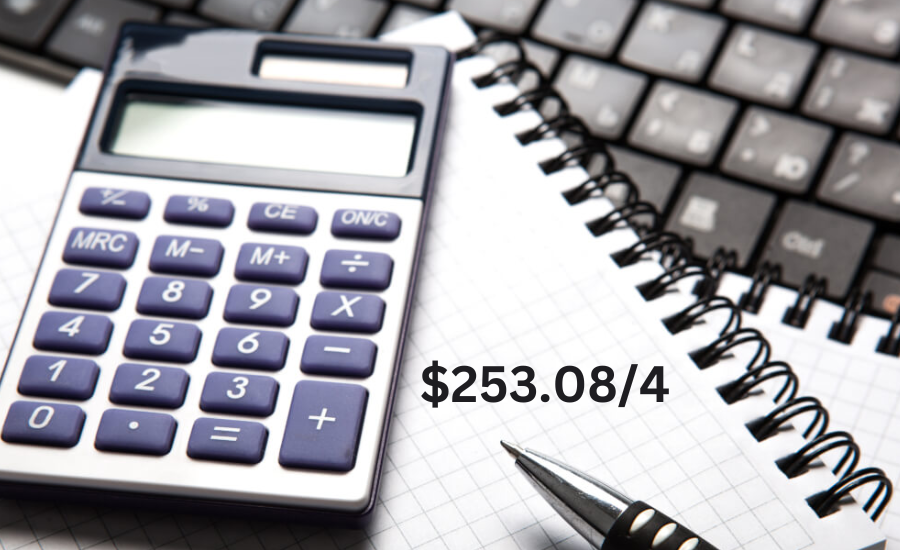Mastering the division of amounts like $253.08/4 is a valuable and practical skill that proves useful in numerous everyday scenarios. Whether you’re splitting a dining expense among friends or calculating quarterly installments for a payment plan, having a solid grasp of this type of calculation can save time and prevent errors. In this guide, we’ll take a detailed look at how to approach and solve this division problem step by step, helping you gain confidence in handling similar financial situations with clarity and precision. Additionally, we’ll explore some practical applications where this skill can be applied, making the concept even more relatable and useful in day-to-day life.
Recognizing the Value of Division in Everyday Situations

Division plays a crucial role in our daily lives, whether it’s for simple calculations or more complex financial tasks. For example, dividing $253.08/4 is a common scenario where understanding how to split an amount equally becomes essential. This basic mathematical operation helps in situations like dividing a restaurant bill evenly among friends or determining periodic payments for a financial obligation. In this guide, we’ll walk through the division process in detail, offering easy-to-follow steps. Beyond just solving the problem, we’ll also highlight the practical uses of division in real-life situations, demonstrating how mastering this skill can bring clarity and efficiency to everyday financial decisions.
Practical Uses of Division in Everyday Life
The ability to divide amounts like $253.08/4 is far more than a simple mathematical concept; it has countless practical applications in daily life. For instance, when shopping, division helps individuals determine the cost per item, enabling smarter comparisons and decisions about which products offer the best value. By dividing the total price by the quantity, consumers can make informed choices about their purchases.
In the kitchen, division is essential for adjusting recipes. If a recipe calls for 2/3 cup of sugar and you want to double or halve the recipe, understanding how to accurately divide and multiply measurements ensures your dish turns out perfectly. Accurate division can make or break a recipe when cooking or baking for different numbers of people.
Travel planning is another area where division proves useful. Travelers often divide the total distance by their speed to calculate how long a trip will take, or they may divide shared expenses to ensure everyone contributes equally to costs like gas or accommodations.
Financial tasks, too, heavily rely on division. Whether you’re calculating interest on a loan, managing your budget, or figuring out monthly payments, division is an essential tool. For instance, dividing $253.08/4 might be needed to determine how to evenly split a bill among friends or to calculate quarterly payments for expenses. Strong division skills can make managing finances simpler and more accurate in a wide range of situations.
Breaking Down the Division of $253.08/4
Division is one of the fundamental operations in mathematics, representing the process of splitting a larger quantity into smaller, equal parts. When dividing $253.08/4, the goal is to evenly distribute the total amount among four equal portions. Essentially, this calculation helps in scenarios where we need to share a specific sum—like $253.08—equally among four people or entities. By applying the principles of division, we ensure that each person or group receives an equal share of the amount, making the concept simple yet highly useful in various financial and everyday contexts.
Breaking Down the Division of $253.08/4: Handling Decimals in Calculation

When dividing an amount like $253.08/4, it’s important to understand that the presence of a decimal point makes the calculation slightly more complex. If we were dealing with just the whole number 253, the division would be straightforward. However, since $253.08 includes both dollars and cents, we need to apply specific rules to ensure accuracy.
The first step is to recognize that the figure consists of two parts: $253 in whole dollars and 8 cents. Although it might seem tempting to divide these parts separately, they must be handled as one complete value—$253.08. Dividing the amount as a whole ensures that the result accurately reflects both the dollars and the cents. Breaking down the entire figure and following the standard steps for division with decimals will help you arrive at the correct result, while also reinforcing the importance of understanding decimal calculations in various financial contexts. This process ensures accuracy, whether you’re calculating shared expenses or managing personal finances.
Step-by-Step Guide to Dividing the Dollar Portion of $253.08/4
To begin, focus on dividing the dollar portion of $253.08, which is $253. Dividing 253 by 4 gives an even result of $63.25. This amount represents each person’s share when splitting the total dollar figure into four equal parts.
How to Divide the Cents in $253.08/4
Next, divide the remaining 8 cents by 4. Splitting 8 cents equally results in 2 cents for each part. This step ensures that the cents are distributed as evenly as the dollar portion.
Combining the Dollar and Cent Portions for the Final Answer
Now that you’ve divided both the dollar and cent portions separately, you can combine them to get the complete result.
- Dollar portion: $63.25
- Cent portion: $0.02
Adding the two gives a final amount of $63.27 for each share. This method ensures that both dollars and cents are divided accurately, making the process easy to follow and apply in real-life situations where precision is important.
Confirming Your Calculation for $253.08/4
Division and multiplication are inverse operations, meaning that one can be used to check the accuracy of the other. To ensure that your division of $253.08/4 is correct, it’s wise to verify your results through multiplication. This step not only reinforces your confidence in the calculation but also serves as a practical check for any potential errors.
In this case, to verify your outcome, take the result of $63.27 and multiply it by 4. The calculation should yield the original amount of $253.08. If the multiplication brings you back to the initial total, you can be assured that your division was performed accurately. This method of verification is a reliable way to confirm your mathematical results and is applicable in various situations where precision is crucial.
A Step-by-Step Method for Division
Calculating $253.08 divided by 4 can be accomplished using a systematic approach that enhances accuracy and clarity. By breaking down the process into straightforward, manageable steps, anyone, even those who may find math challenging, can successfully arrive at the right answer. Let’s delve into the calculation process step by step.

Aligning the Decimal Point Correctly
The first essential step in dividing $253.08 by 4 is to ensure the decimal point is properly aligned. This alignment is crucial to maintaining the integrity of the value during the calculation. Since the dividend ($253.08) already includes a decimal, we will move it directly up into the quotient area above the division bracket.
To set up the problem, write $253.08 within the division bracket and place 4 outside as the divisor. Make sure to bring the decimal point straight up, ensuring that the final result is expressed correctly in dollars and cents.
Carrying Out the Division Process
With the decimal point aligned, you can now proceed with the division. Let’s take a thorough look at the steps involved:
- Start with the first digit: Look at the leftmost digit of the dividend. Since 4 cannot fit into 2, move to the next digit.
- Consider 25: Determine how many times 4 fits into 25. It divides evenly 6 times, with a remainder of 1. Record the 6 above the 5 in the quotient.
- Perform the multiplication: Take 6 and multiply it by 4 to obtain 24. Subtract this from 25, which leaves a remainder of 1.
- Bring down the next digit: Add the next digit, which is 3, creating a new number of 13.
- Continue the process: Write 3 next to the 6 in the quotient. Multiply 3 by 4 to get 12, then subtract this from 13, leaving a remainder of 1.
- Add the next digit: Bring down the next digit, 0, forming the number 10.
- Divide again: Divide 10 by 4, which fits 2 times with a remainder of 2. Write 2 in the quotient.
- Multiply and subtract: Multiply 2 by 4 to get 8. Subtract this from 10, resulting in a remainder of 2.
- Bring down the last digit: Add the last digit, 8, creating 28.
- Final division: Divide 28 by 4, which fits perfectly 7 times. Write 7 as the final digit in the quotient.
- Complete the calculation: Multiply 7 by 4 to get 28. Subtracting this from 28 results in no remainder.
The final result of this division is $63.27, indicating that when $253.08 is divided by 4, each portion amounts to $63.27.
It’s important to remember that when dividing numbers with decimals, treat the figures following the decimal as part of the overall value while being attentive to the decimal point’s placement in the final answer. Since we moved the decimal point straight up at the beginning, our answer is appropriately formatted.
Building Confidence through Practice
Regular practice with division problems like $253.08 divided by 4 will sharpen your skills and boost your confidence. The more frequently you practice these calculations, the more skilled you will become. Don’t let mistakes discourage you—view them as valuable learning opportunities that are crucial for enhancing your mathematical proficiency.
The Significance of Rounding and Estimation in Daily Calculations
Rounding is an essential tool in various situations, particularly when a close approximation is sufficient or when dealing with complex numbers that are difficult to compute in your head. Whether you’re splitting a bill with friends at a restaurant or estimating your quarterly payments, rounding provides a quick way to arrive at an answer that is good enough for practical purposes.
To ensure accuracy in calculations, it is generally recommended to reserve rounding until the final result. This approach minimizes the risk of accumulating errors that may arise from premature rounding. However, in mental math situations, rounding earlier in the process can often simplify calculations.
For instance, when dividing $253.08 by 4, one might consider rounding the amount down to $250. This slight adjustment can make mental calculations easier while still providing a reasonably accurate estimate. The extent of rounding should be in line with the level of precision required for the final outcome.
In some cases, using opposite rounding strategies can help further reduce errors. For example, when multiplying two numbers, rounding one figure up and the other down can lead to a more precise overall estimate. This technique can be particularly beneficial when calculating $253.08 divided by 4, allowing for quicker mental arithmetic without sacrificing accuracy. By leveraging rounding and estimation effectively, you can enhance your mathematical skills and make everyday calculations more manageable.
Mastering the Art of Estimation

Estimation is a valuable skill that complements precise calculations by enabling you to quickly arrive at a result that closely approximates the actual outcome. This involves rounding numbers to more manageable values, such as to the nearest decimal, ten, or hundred. For example, when estimating the division of $253.08 by 4, rounding the amount down to $250 simplifies the mental calculation, resulting in an approximate answer of $62.50.
To estimate effectively, follow these steps:
- Round the Dividend: Begin by rounding the dividend ($253.08) to a nearby, easier number, such as $250 or $260.
- Evaluate the Divisor: In this case, the divisor (4) remains a whole number, so there’s no need to round it.
- Perform Mental Division: Use the rounded figures to carry out the mental division.
This method allows for quick mental calculations that can serve as a rough validation of the precise result. If your estimate is significantly different from the exact calculation, it may indicate a mistake in the detailed work.
Estimation is particularly useful in scenarios like budgeting and shopping. For instance, if you’re considering purchasing an item priced at $253.08, rounding it up to $260 can ensure that you have enough funds available. This technique can provide a financial buffer, helping you avoid overspending.
While estimation is a powerful tool, it shouldn’t replace precise calculations when accuracy is paramount. The goal of estimation is to provide a quick, reasonably accurate answer that helps assess the feasibility of a more detailed figure.
For the division of $253.08 by 4, an estimate indicates that the result should be slightly over $60. This rapid mental check can help pinpoint major errors during the exact calculation process, such as misplaced decimal points or simple arithmetic mistakes.
By combining rounding and estimation with exact calculations, you can approach problems like $253.08 divided by 4 with greater confidence and efficiency. These techniques not only save time but also deepen your understanding of numerical relationships, ultimately enhancing your overall mathematical skills.
Conclusion
Mastering the division of amounts, such as $253.08 by 4, is a valuable skill that simplifies everyday tasks like splitting bills and managing budgets, enhancing decision-making and financial awareness. This guide outlines a step-by-step approach to division, emphasizing the importance of estimation and rounding for quick approximations, particularly in budgeting and shopping scenarios. With consistent practice, individuals can build confidence in their mathematical abilities, ultimately viewing division as an essential tool that supports various aspects of daily life.
Frequently Asked Questions (FAQs)
Q: Why is division important in everyday life?
A: Division is essential for making various everyday calculations more manageable, such as splitting bills, budgeting, and determining costs per item while shopping. It enables individuals to make informed decisions in both personal finance and daily activities.
Q: How can I effectively estimate a division problem?
A: To estimate a division problem, round the dividend (the number being divided) to a more manageable number and perform the division using these rounded figures. For example, rounding $253.08 to $250 when dividing by 4 simplifies the mental calculation while still yielding a reasonable estimate.
Q: What should I do if I encounter decimals in division?
A: When dividing numbers with decimals, keep the decimal point aligned correctly. Treat the entire value as a single figure and follow standard division steps. Remember to bring the decimal point straight up into the quotient area.
Q: How can I verify my division results?
A: You can verify your division by using multiplication. Take your division result and multiply it by the divisor. If the product equals the original dividend, your division calculation is likely accurate.
Q: What are some practical applications of division beyond splitting bills?
A: Division is widely applicable in budgeting, recipe adjustments, travel planning, and financial management, such as calculating interest or monthly payments. These applications help streamline daily tasks and enhance decision-making skills.



